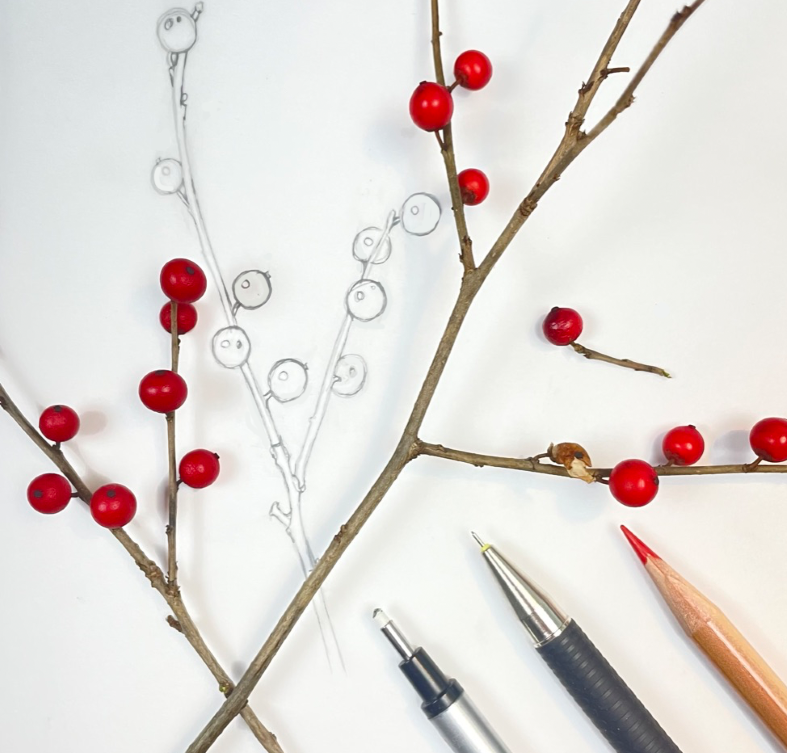I was recently reminded of an email I sent as a New Year message for botanical artists in 2019. The person who mentioned it said that she had come across it in her files and found it to be as inspiring now as it was then.
This made me dig into my old email files and retrieve it. And I must say that my New Year message for botanical artists is no different now in 2022 than it was in 2019. And while the pandemic has changed many things since 2019, my message is the same. So, here it is, my new Year message for botanical artists . . .
Five wishes for 2022 (edited slightly from the 2019 original)
1. Connect with nature as often as you are able. It feeds your inner wellbeing.
I say this confidently out of knowledge and experience. Michael and I moved right across Canada from an inner city neighbourhood in Calgary to rural Nova Scotia. I worried about the transition—it seemed such a drastic change. I am not sure why though—the list of rewards are definitely too numerous to be included here. And as if launching my e-book bookstore isn’t enough, I am also now in a state of inspiration overload—a ‘condition’ I wish for all of you too.
2. Make time for art and draw, draw, draw (even in winter)
One of the procrastinating excuses botanical artists offer themselves is that just setting up to do a botanical study takes time and the art form is not a stop-start activity. This contention feeds inertia. It may be true of full-scale studies in whatever medium you prefer, but not true for sketching and drawing. Drawings hold such potential for great works later—it gets you going and it keeps you going. To cope with inspiration overload I gathered specimens (admittedly, too many) in the summer and I now have numerous drawings and colour matching completed. This is going to keep me busy for the entire winter and probably way beyond that. So stop listening to that inner voice that fuels procrastination and “Just do it!”
3. Connect with your art community and share your art with others
Join ASBA for all their incredible opportunities and connections. I have been a member since 2001 and have treasured relationships with artists around the globe as a result. Every year artists tell me that exhibitions are very stressful. Organizing them . . . well, um, yes, indeed … but participating is motivational. It offers you a direction and a goal, and seeing your painting hanging in a group exhibition with your fellow artists is incredibly rewarding. Be part of every open exhibition you can find. If your work is rejected for a juried exhibition, seek informed opinions to find out why. I did, and I learned in a hurry what I needed to do. I refused to drown myself in the silly head stuff. Replace the ego bruising with a positive “I can do this!.” Keep calm and carry on!
4. Finish some of those abandoned “in progress” pieces
We all have them. Artists tell me about them all the time as if this were a negative by-product of workshops. Stalling at the ‘ugly duckling stage’ just breeds pointless doubt and further inertia. ‘Ugly ducklings’ can turn into swans, so what’s the risk in taking further steps to finish? A fantastic book (by Walter Isaacson) on the life of one of my personal icons, Leonardo Da Vinci, offers an incredible insight into the artist’s mind. Leonardo’s genius was profound but he suffered from serious inertia; he had many abandoned commissions and incomplete works. It makes me sad to think about the resultant losses. But thank goodness for his vast legacy of drawings that document his progression. So please don’t let inertia rule you. Dig those unfinished works out and finish at least some of them.
5. Research and discover plants to paint that can promote preservation awareness
Embrace the information aspects of your beloved art form. Portray the endangered species to help the cause of badly-needed public awareness. My research into the topic has taken me to some interesting places and helped acquire a host of new contacts. For just one instance, I was ecstatic to hear that a rare and endangered lichen has been found to be increasing here in Nova Scotia. As lichens are barometers of air quality this is great news. We have an important role to play with our art form.

